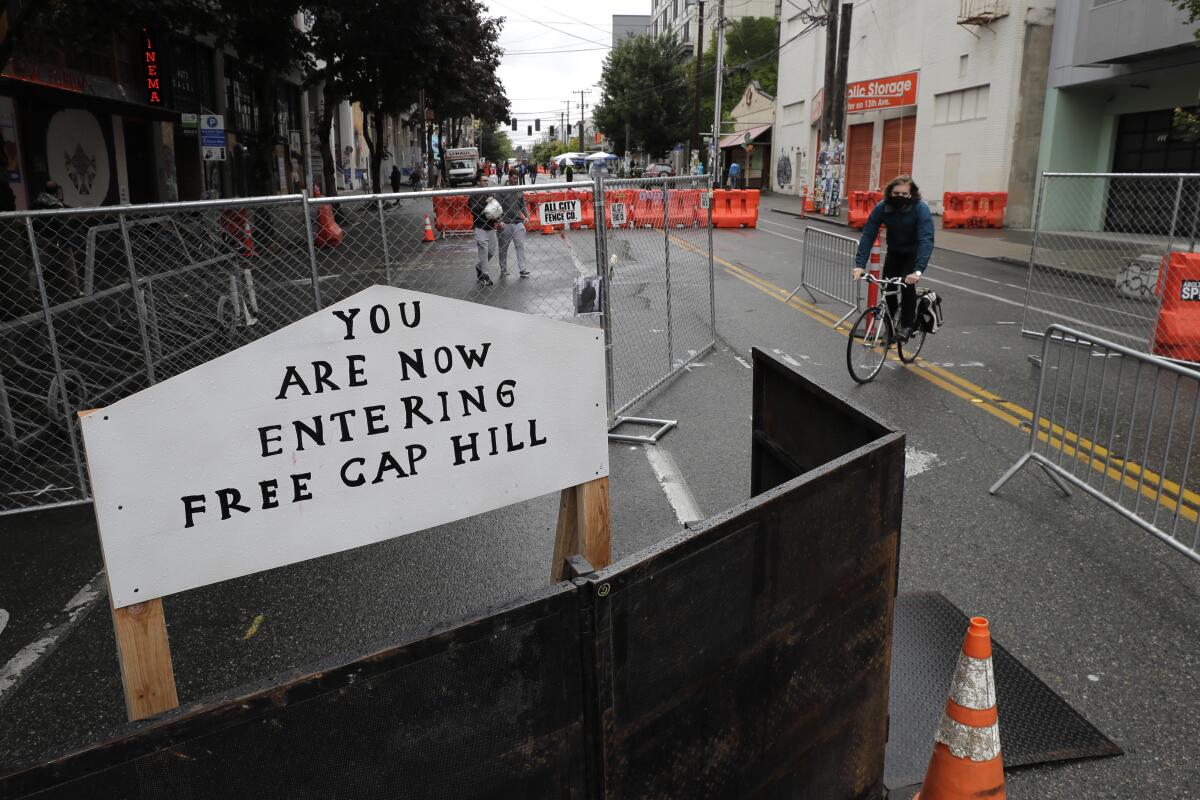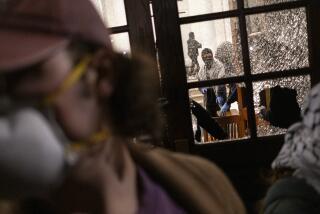Q&A: What’s next for Seattle protesters’ ‘autonomous zone’?

- Share via
SEATTLE — For nearly a week, people opposing police brutality and racial injustice have turned a Seattle neighborhood into ground zero for their protests, creating a carnival-like atmosphere with speakers and drum circles near a largely abandoned police station.
While protesters say it shows how people can manage without police intervention, it’s drawn scorn from President Donald Trump, who has repeatedly threatened to “go in” to stop the “anarchists” he says have taken over the liberal city after officers withdrew to ease tensions.
Washington’s governor and Seattle’s mayor, both Democrats, have rebuked Trump and say local officials are trying to find a peaceful resolution following demonstrations that turned violent last weekend.
A look at what’s going on in Seattle:
WHAT IS THE “CAPITOL HILL AUTONOMOUS ZONE”?
It stretches for several blocks in the densely packed Capitol Hill neighborhood just east of downtown Seattle and sprung up after police removed barricades near a police station Monday and largely left the building.
It came after officers used tear gas, pepper spray and flash bangs last weekend to disperse demonstrators they said were assaulting them with projectiles.
Signs along the sidewalks proclaim “You are entering free Capitol Hill” and “No cop co-op.” Throughout the day, speakers use microphones to discuss their demands. Artists have painted a block-long “Black Lives Matter” mural on the street. Many businesses are still open.
WHAT DO PROTESTERS WANT?
They come from a variety of groups and interests, ranging from Black Lives Matter organizers to labor and neighborhood groups. Most want the police precinct to be turned into a community center and much of the department’s funding to be redirected to health and social services.
“What you see out here is people coming together and loving each other,” said Mark Henry Jr. of Black Lives Matter. “I see people coming from different walks of life ... learning from each other.”
WHAT IS TRUMP SAYING?
In a series of tweets, Trump has taunted Gov. Jay Inslee and Mayor Jenny Durkan and said Seattle had been taken over by “anarchists.”
“These Liberal Dems don’t have a clue. The terrorists burn and pillage our cities, and they think it is just wonderful, even the death. Must end this Seattle takeover now!” Trump tweeted Friday.
His comments come as he’s pushed for a stronger response to protesters nationwide. Following last weekend’s unrest, the protests in Seattle have been largely peaceful.
In a Thursday interview with the Fox News Channel, the president said, “If we have to go in, we’re going to go in. These people are not going to occupy a major portion of a great city.”
In response, Durkan said it would be “unconstitutional and illegal to send military to Seattle.”
HOW HAVE POLICE REACTED?
Police Chief Carmen Best said the decision to leave the Capitol Hill precinct wasn’t hers and she was angry about it. In a video message to officers this week, she also reiterated that police had been harassed and assaulted during protests.
“Ultimately, the city had other plans for the building and relented to severe public pressure,” Best said.
Durkan said in a statement that she decided to remove the barriers around the station in an effort to deescalate tensions.
Best said in an interview Friday on “Good Morning America” that officials had to remove some personnel for a short period, then it became unsafe for officers to go back.
Police initially said protesters in the “autonomous zone” had harassed and intimidated residents and businesses but later eased off those statements and said they had no concrete evidence of that.
While Best said she supports free speech, “this is not that.”
WHAT’S NEXT?
The police chief said Friday that officials were working to get officers back into the precinct, stressing the “need to have officers responding to calls in a timely fashion. And with the occupation that’s taking place, we’re not able to do so in a timely way.”
She says police want to ensure they’re responding to community concerns, keeping people safe and making their response “proportionate to what we’re addressing.”
On the first weekend of protests in late May, there was widespread destruction downtown as people smashed storefront windows and stole merchandise. Last weekend, police were criticized after they used tear gas and flash bangs to disperse crowds on Capitol Hill that they said had become unruly, soon after pledging to temporarily stop using a type of tear gas.
Some City Council members and other elected officials say authorities overreacted, and both Durkan and Best have faced calls to resign.
The mayor said she doesn’t want a repeat of last weekend’s violence.
“The chief, together with residents, neighborhood, community and a number of city departments are looking at how we address a whole range of things on Capitol Hill,” Durkan said, adding there was no set date for specific action by police or the city.
More to Read
Sign up for Essential California
The most important California stories and recommendations in your inbox every morning.
You may occasionally receive promotional content from the Los Angeles Times.










